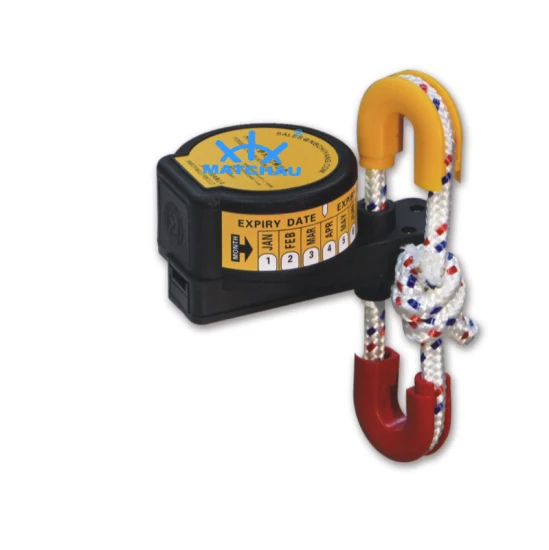When out at sea, understanding the function of a Hydrostatic Release Unit (HRU) could mean the difference between safety and peril. Imagine a device that responds to underwater pressure, automatically deploying life-saving equipment when conditions become dire. The intricacies of how this mechanism operates and the various types available are not only fascinating but could be crucial knowledge for any boater. Stay tuned to unravel the mystery behind HRUs and discover why they are indispensable tools for maritime safety.
Importance of HRUs in Boating Safety
Hydrostatic Release Units (HRUs) play an essential role in boating safety by automatically deploying life rafts in emergency situations.
These devices are significant components of emergency preparedness on watercraft, ensuring compliance with boating regulations and enhancing the chances of survival during critical incidents.
In many jurisdictions, boating regulations mandate the use of HRUs on vessels as part of safety measures to protect passengers and crew.
By automatically releasing life rafts when submerged under a certain water pressure, HRUs guarantee swift deployment of life-saving equipment in emergencies such as vessel sinking or capsizing.
This rapid response is imperative for effective evacuation and rescue operations, especially in situations where manual deployment may not be feasible.
Functionality of Hydrostatic Release Units
How do Hydrostatic Release Units function to secure the automatic deployment of life rafts in essential situations on watercraft?
Hydrostatic Release Units operate based on the principles of hydrostatic pressure. These units are designed to activate when submerged at a specific depth underwater. The release mechanisms within HRUs are engineered to respond to changes in water pressure, triggering the release of life-saving equipment such as life rafts or EPIRBs (Emergency Position Indicating Radio Beacons).
When a watercraft sinks or capsizes, the increasing water pressure at a certain depth causes the HRU to release the life raft it holds. This automatic deployment guarantees that the life-saving equipment is accessible when needed most.
How Hydrostatic Release Units Work
To understand the workings of hydrostatic release units, it’s essential to explore the intricate mechanisms that enable their functionality. These units operate based on hydrostatic principles and release mechanisms that guarantee their effectiveness in emergency situations.
Here is a breakdown of how hydrostatic release units work:
- Hydrostatic Principles: These units rely on the pressure exerted by water at specific depths to trigger their release mechanism.
- Activation Mechanism: When submerged to a predetermined depth, the increasing water pressure compresses a chamber within the unit, initiating the release process.
- Linkage System: Once the chamber is compressed sufficiently, it activates a linkage system that releases the unit from its mounting, allowing it to float to the surface.
- Buoyancy Aid: As the unit rises, its inherent buoyancy aids in bringing the attached equipment or life raft to the surface, ready for deployment.
Types of Hydrostatic Release Units
For a thorough understanding of hydrostatic release units, it’s essential to explore the various types that cater to specific needs and applications.
There are two main types of hydrostatic release units: manual release and automatic activation.
Manual release HRUs require a person to physically activate them. These units are simple in design and function, relying on manual intervention to release the mechanism. They’re commonly used in situations where immediate and intentional release is necessary, such as in life rafts or emergency beacons.
On the other hand, automatic activation HRUs are designed to release automatically when submerged to a certain depth. These units are ideal for situations where human intervention mightn’t be possible, such as when a vessel is sinking rapidly.
Automatic activation HRUs offer a hands-free solution for deploying safety equipment swiftly and efficiently.
Understanding the differences between manual release and automatic activation HRUs is vital in selecting the appropriate unit for specific maritime safety needs.
Maintenance and Inspection of HRUs
Why is regular maintenance and inspection essential for guaranteeing the best performance and reliability of hydrostatic release units (HRUs)? Proper care and monitoring of HRUs are vital to extend their lifespan and prevent malfunctions.
Here are four key aspects to take into account for effective maintenance and inspection:
- Regular Checks: Conduct routine inspections to confirm the HRU is in ideal condition.
- Seal Integrity: Check the seals for any signs of wear or damage that could affect the unit’s performance.
- Function Testing: Perform regular function tests to verify that the HRU will release properly in an emergency.
- HRU Troubleshooting: Be prepared to troubleshoot any issues promptly to maintain the unit’s reliability.
Regular maintenance and inspection not only enhance the performance of HRUs but also contribute to the overall safety and effectiveness of maritime operations.
Frequently Asked Questions
Are Hydrostatic Release Units Required by Law on Boats?
Yes, hydrostatic release units are essential on boats for regulatory compliance with safety standards. These devices automatically release life rafts in emergencies when submerged in water. They are mandatory for ensuring vessel safety.
Can HRUS Be Reused After Deployment?
After deployment, HRUs cannot be reused. Proper HRU maintenance includes regular testing to guarantee functionality. Testing verifies that the unit releases at the correct pressure. Always replace HRUs after use to maintain safety standards.
How Long Is the Typical Lifespan of an HRU?
To guarantee the longevity of your HRU, adhere to maintenance tips provided by the manufacturer. Factors influencing lifespan include environmental conditions, usage frequency, and proper installation. Regular inspections and adherence to guidelines can extend the unit’s lifespan.
Do HRUS Work in Extreme Weather Conditions?
In extreme weather conditions, HRUs require meticulous maintenance to guarantee ideal function. Harsh elements can impact HRU performance; regular checks and proper upkeep are essential. Protect your safety by monitoring HRU maintenance diligently to counter extreme weather effects.
Are There Any Alternatives to Hydrostatic Release Units?
When considering alternatives to hydrostatic release units, you can explore mechanical alternatives or electronic systems. These options offer different mechanisms for releasing safety devices in emergency situations, ensuring diverse solutions for different needs and preferences.







